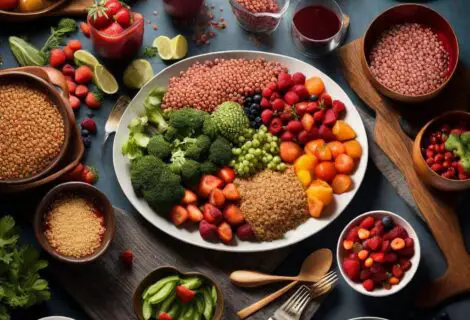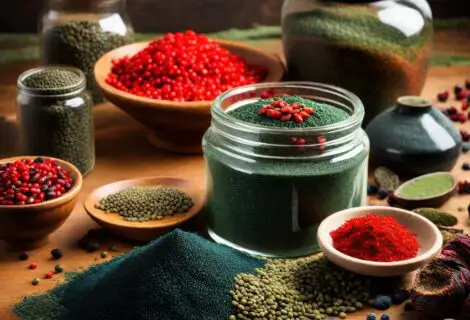The Importance of Fiber and the Best High Fiber Foods
Introduction
Fiber is an important part of a healthy diet that unfortunately often gets overlooked. Consuming enough fiber each day provides many health benefits and can help prevent various diseases and conditions. This article will discuss the importance of fiber, recommended daily amounts, the best high fiber food sources, and tips for adding more fiber into your diet.
Health Benefits of Probiotics and the Best Food Sources
Why Is Fiber Important?
Fiber provides several key functions and benefits in our bodies:
Promotes Digestive Health
Fiber adds bulk to stool and helps food pass more quickly through the digestive tract. This helps relieve and prevent constipation by keeping you regular. It also helps reduce pressure and straining during bowel movements.
Supports Heart Health
Soluble fiber helps lower LDL (bad) cholesterol levels. It also reduces the risk of heart disease, stroke, and high blood pressure.
Manages Blood Sugar Levels
Fiber, especially soluble fiber, slows the absorption of sugar to help prevent spikes and crashes in blood sugar levels. This is especially beneficial for those with diabetes.
Aids Weight Loss
High fiber foods tend to be more filling while being lower in calories. Fiber helps control hunger and cravings to support weight loss and maintenance.
Reduces Disease Risk
Diets high in fiber have been associated with a reduced risk of certain cancers, diabetes, heart disease and bowel disorders.
The Mediterranean Diet: A Complete Guide with Meal Plan
How Much Fiber Do You Need?
The recommended dietary allowance for fiber is:
- Men age 50 or younger: 38 grams daily
- Men over age 50: 30 grams daily
- Women age 50 or younger: 25 grams daily
- Women over age 50: 21 grams daily
Unfortunately, most Americans only get about half the amount of fiber they need each day. So, make a conscious effort to incorporate more high fiber foods into your meals and snacks.
How to Follow a Gluten-Free Diet: Tips and Meal Plan
The Best High Fiber Food Sources
Adding more plants to your diet is the easiest way to increase your daily fiber intake. Here are some of the top high fiber foods to include:
Vegetables
- Artichokes
- Green peas
- Broccoli
- Brussels sprouts
- Carrots
- Sweet potatoes
- Spinach
Fruits
- Raspberries
- Pears (with skin)
- Apples (with skin)
- Bananas
- Figs
- Avocados
Grains
- Oatmeal
- Popcorn
- Whole grain bread
- Quinoa
- Brown rice
- Barley
Nuts & Seeds
- Almonds
- Pistachios
- Chia seeds
- Flaxseeds
- Sunflower seeds
Legumes
- Split peas
- Lentils
- Black beans
- Edamame
- Kidney beans
Other
- Chia Pudding
- Flaxseed meal
- Dark chocolate (70%)
- Trail mix
When buying processed grains like bread, cereal or crackers, read the label and aim for at least 3 grams of fiber per serving.
Tips for Increasing Your Fiber Intake
Transition to a high fiber diet gradually to avoid gas or bloating. Here are some simple ways to work more fiber into your daily routine:
- Choose whole fruits over juice.
- Add berries, banana or avocado to your morning smoothie.
- Use lettuce wraps instead of buns for burgers.
- Snack on raw veggies and hummus.
- Add beans or lentils to soups, salads and rice dishes.
- Swap white rice or pasta for quinoa or whole grains.
- Sprinkle nuts, seeds or bran cereal on top of yogurt.
- Eat the skins/peels of fruits and veggies when possible.
- Replace candy or chips with high fiber snacks like popcorn.
- Use whole grain flour in baking recipes.
- Drink plenty of water to aid digestion.
Mastering Plant-Based Meal Planning
Conclusion
Making fiber a priority and including more high fiber plant foods in your diet provides tremendous benefits for digestion, heart health, blood sugar levels, weight control and disease prevention. Try incorporating some of the high fiber foods and tips mentioned here to ensure you are getting at least 25-38 grams daily, depending on your gender and age. Small, gradual changes can make a big difference over time!
What steps will you take to increase your daily fiber intake? Are there any high fiber foods you enjoy that weren’t mentioned? Share your thoughts and experiences in the comments below! I’d love to hear your favorite tips and go-to high fiber food sources.
Discover the Benefits of Vitamin B12: A Complete Guide
Frequently Asked Questions About Fiber
Why is fiber good for weight loss?
Fiber is beneficial for weight loss because high fiber foods tend to be lower in calories and more filling. Soluble fiber absorbs water to form a gel-like substance in your digestive tract. This slows digestion, helps control hunger hormones, and prevents overeating.
What foods have the highest fiber?
Beans, lentils, avocados, berries, broccoli, artichokes, and bran cereals are some of the foods highest in fiber per serving. Nuts, seeds, whole grains, and dark leafy greens also contain lots of fiber.
How can I get more fiber in my diet?
Eat more whole fruits and vegetables, beans/legumes, whole grains, nuts and seeds. Read nutrition labels and choose products with at least 3g of fiber per serving. Add chia seeds, flaxseed, or bran cereal to foods. Gradually increase fiber to avoid digestive issues.
What are symptoms of too much fiber?
Consuming too much fiber too quickly can cause gas, bloating, cramps, diarrhea and other digestive issues. Drink plenty of water and increase fiber gradually over a few weeks. See a doctor if severe symptoms persist.
What are soluble vs insoluble fibers?
Soluble fiber dissolves in water to form a gel-like substance during digestion. Insoluble does not dissolve. Both types provide health benefits and should be consumed daily from foods.
What foods have insoluble fiber?
Insoluble fibers are found in foods like whole grains, bran, nuts, seeds, vegetables, and wheat. They help add bulk and move food through the digestive tract. Sources include whole grains, nuts, veggies, and fruits.
What foods contain soluble fiber?
Soluble fiber is found in oatmeal, beans, lentils, apples, oranges, carrots, barley, and psyllium husk. It dissolves to form a gel-like consistency during digestion, helping lower cholesterol and control blood sugar.








